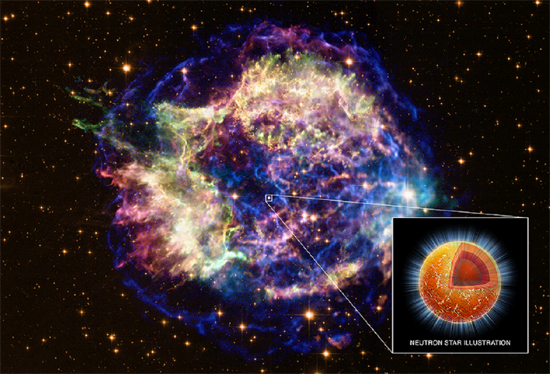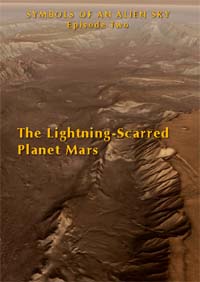|

The remains of an exploding double
layer known as Cassiopeia A with an
artist's impression of a theoretical
entity called a neutron star. Credit
X-ray: NASA/CXC/UNAM/Ioffe/D. Page,
P. Shternin et al; Optical: NASA/STScI;
Illustration: NASA/CXC/M. Weiss
Andromeda's Mother
Mar 02, 2011
Rather than searching for
exotic explanations, this celestial
object can best be described using
plasma physics.
According to a recent
announcement from the
Chandra X-ray Observatory, the
so-called "supernova remnant"
Cassiopeia A (or "Cas A") harbors a
strange passenger within the neutron
star that is supposed to inhabit its
interior, a form of superconductor
known as a superfluid.
As theory suggests, neutron stars
form when large stars exhaust their
fuel supplies as they age. Once a
star with about five times the mass
of our Sun accumulates enough
thermonuclear "ash" composed of
non-fusible elements like iron in
its core, it undergoes a
catastrophic implosion. Since
nuclear reactions can no longer be
sustained, the star becomes the
victim of its own gravity field. The
star's outer surface collapses
inward at tremendous speed,
rebounding off the dense core
material. The star then erupts
outward in a supernova explosion,
blasting its outer layers into
space, releasing X-rays, gamma rays,
and extreme ultraviolet.
Depending on the mass of the
star, the remaining stellar core
material might remain as a hot,
white dwarf star, or if it is large
enough, the gravity field will pull
all the electrons out of their
atomic orbits and squeeze them into
the nucleus, forming neutrons. The
star will become what
astrophysicists call a "neutron
star" with unbelievable density and
gravitational attraction. It is
commonly said that a teaspoon of
neutron star stuff would posses an
inertial mass in the billions of
tons. A neutron star is thought to
exist at the center of the Cas A
nebular cloud.
In the image at the top of the
page, various frequencies of X-rays
are shown in red, green, and blue.
Since X-rays are invisible, the
colors are arbitrary and are either
assigned by a computer program or a
graphic interpreter who's job is to
create images for public release.
The interesting thing about the
X-ray distribution is
that they are englobing the central
star, with tendrils of plasma
interconnecting other glowing
regions.
In a
previous Picture of the
Day, the fact that supernova
explosions emit X-rays was used to
support the contention that
supernovae are not kinetic events
resulting from gravitational
collapse, rebound, or shockwaves.
Instead, they are electrical in
nature, with behavior that cannot be
calculated based on simple Newtonian
mechanics. Rather, plasma physics
and the action of electrodynamic
forces should be brought to bear in
order to unlock their puzzles.
It is a principle of science that
one should begin with the simple and
then continue to the more complex if
the situation warrants that step. 2
+ 2 = 4 does not require algebraic
equations to solve it. If the
foundational precepts of Electric
Universe theory, based on
well-established, Nobel-vetted work
by dedicated researchers in the
physics of high-energy plasma
provides concise, laboratory
replicated answers to the puzzle of
supernovae, then this writer submits
that that is the most logical place
to begin an exploration.
Although Electric Universe
responses to the Chandra team's
announcement provide a sober minded
explanation, what is it that the
researchers themselves conclude?
As the artist's impression at the
top if the page indicates, they
conclude that a neutron star,
something never observed by any
telescope, has a crust (orange) and
a core (red). The core temperatures
are estimated to be a billion
degrees Celsius. The blue rays are
supposed to be neutrinos escaping
from the neutron star, causing it to
cool off, forming a neutron
superfluid.
A research team leader, Peter
Shternin of the Ioffe Institute in
St. Petersburg, Russia said: "The
rapid cooling in Cas A’s neutron
star, seen with Chandra, is the
first direct evidence that the cores
of these neutron stars are, in fact,
made of superfluid and
superconducting material."
The remainder of the press
release contains what appears to be
sheer speculation involving the
predictions of mathematical models
and how mathematical entities like
neutron stars ought to behave. If
the astronomical community was not
so serious about their contentions,
it would be tempting to think they
were being ironic.
Contrasting the Electric Universe
perspective with that of consensus
science can be instructive. In the
first sense there is simplicity,
experimental evidence, mathematical
illustration backed by laboratory
analysis: explanations that can be
communicated easily to almost any
audience. In the second, arcane
mathematical reifications are placed
onto a stage created out of computer
models: characters acting out
scripted roles. Neutron stars can
never be experimentally verified.
The scalable nature of plasma's
electrical and physical properties
is critical when it comes to
investigating the cosmos. In the
laboratory, effects that model those
in space can be created. Gravity's
effects are not scalable in the
laboratory. Gravitational force
falls off with the square of the
distance, where the attraction
between electrified filaments is
linear and is up to 39 orders of
magnitude greater. Gravity is too
weak to model.
Virtual models operating within
computer algorithms have replaced
direct observation in many ways.
Models are used to support the
existence of yet more models. Models
are used to build other models,
which, in turn, are used to
"confirm" further models. Physics
used to mean investigating the
nature and properties of matter and
energy. Instead, astrophysics has
become an apprentice to mathematics.
Stephen Smith
Multimedia

The Lightning-Scarred Planet Mars
Symbols of an Alien Sky
DVD episode 2
A video documentary that could change everything you thought you knew
about ancient times and symbols.
The Symbols of an Alien Sky video series will introduce you to celestial
spectacles and earth-shaking events once remembered around the world.
Archaic symbols of these events still surround us, some as icons of the
world’s great religions, though the origins of the symbols appear to be
lost in
obscurity.
In this second episode of Symbols of an Alien Sky, David
Talbott takes the viewer on an odyssey across the surface of Mars.
Exploring feature after feature of the planet, he finds that only
electric arcs could produce the observed patterns. The high resolution
images reveal massive channels and gouges, great mounds, and crater
chains, none finding an explanation in traditional geology, but all
matching the scars from electric discharge experiments in the
laboratory.
(Approximately 85 minutes) See:
Lightning-Scarred
Planet info
|








